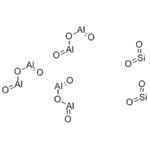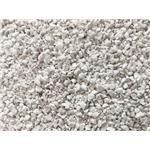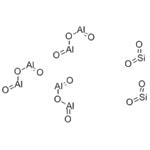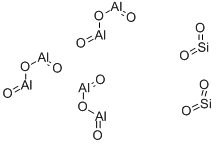- Mullite
-

- $0.00 / 1KG
-
2024-08-17
- CAS:1302-93-8
- Min. Order: 1KG
- Purity: 99.0%
- Supply Ability: 10000KG
- mullite
-

- $0.90 / 1piece
-
2024-05-27
- CAS:
- Min. Order: 100piece
- Purity: 99.5%
- Supply Ability: 20T
- MULLITE
-

- $8.00 / 1kg
-
2024-04-24
- CAS:1302-93-8
- Min. Order: 1kg
- Purity: 99%
- Supply Ability: g-kg-tons, free sample is available
|
| | MULLITE Basic information |
| Product Name: | MULLITE | | Synonyms: | mullite(al6o5(sio4)2);MULLIT;MULLITE;ALUMINUM OXIDE-SILICON OXIDE;ALUMINUM SILICATE, POWDER;92700, MULLITE (LATTICE SPACING, OTHER P;MULLITE, LATTICE SPACING AND OTHER PARAMETERS(CRM STANDARD);REFRACTORYMULLITEFIBRE | | CAS: | 1302-93-8 | | MF: | Al6O13Si2 | | MW: | 426.05 | | EINECS: | 215-113-2 | | Product Categories: | Inorganics | | Mol File: | 1302-93-8.mol |  |
| | MULLITE Chemical Properties |
| Melting point | 1750℃ [JAN85] | | density | 3.16 g/cm3 | | solubility | insoluble in H2O, acid solutions, HF | | form | powder | | color | White | | Water Solubility | Insoluble in water. | | Exposure limits | ACGIH: TWA 1 mg/m3
OSHA: TWA 15 mg/m3; TWA 5 mg/m3 | | EPA Substance Registry System | Mullite (Al6O5(SiO4)2) (1302-93-8) |
| Safety Statements | 22-24/25 | | WGK Germany | 3 | | RTECS | BD1450000 | | TSCA | Yes |
| | MULLITE Usage And Synthesis |
| Description | Mullite [Al6Si2O13 = 3Al2O3·2SiO2], with 71.8 wt.% Al2O3 , is an important silicate mineral that
occurs in high-silica alumina refractories. Mullite exhibits a high melting point of 1810°C
combined with low thermal expansion coefficients (i.e., 4.5 × 10–6 K–1 parallel to the a-axis
and 5.7 × 10–6 K–1 parallel to the c-axis), a good mechanical strength with a tensile strength of
62 MPa, and resilience at elevated temperatures that make mullite a highly suitable mineral
for highly refractory materials. In nature, mullite is an extremely scarce mineral that occurs
only in melted argillaceous inclusions entrapped in lavas from the Cenozoic Era on the Island of Mull, Scotland, but no deposit was found to be economically minable. | | Chemical Properties | colorless; rhomb, a=0.7557nm, b=0.76876 nm, c=0.28842 nm; hardness: hot pressed 13.6GPa, sintered 12.7GPa; indentation microfracture 2.02MPa ·m1/2; submicrometer powder(s) can be prepared by hydrolysis of mixed alkoxides, followed by drying and calcining up to 1600°C; sinter, microstructure [SOM91]; phases equilibria in mullite [PAS88]; other data in [HIR89] [ROB67] [MIZ89] | | Uses | Mullite is present in the form of needles in porcelain, it is used in high-mullite based products is in hot blast stove checker bricks, melting and firing processes, and is used as a refractory material, manufacture of a type of crucible, steel industry, electronic substrates and protective coatings. | | Industrial uses | Artificial mullite, or synthetic mullite, a ceramic material made by a prolonged fusing in the electric furnace of a mixture of silica sand or diasphoric clay and bauxite, has the composition 3Al2O3·2SiO2, has a melting point of 1810 C, and softens at 1650 C.
Mullite occurs in nearly all ceramic products containing alumina and silica but, with the exception of refractories, is seldom introduced as such except as calcined kyanite.
The bricks are resistant to flame and to molten ash, and have a low, uniform coefficient of thermal expansion and a heat conductivity only slightly above that of fireclays. Normally, mullite has very fine crystals that change form and become enlarged after prolonged heating, making the product porous and permeable. For stable high-temperature refractories the mullite is prefused to produce larger crystals. At very high temperatures mullite tends to decompose to form corundum and alkali-silicate minerals of lower heat resistance. Mullite is also used for making spark plugs, chemical crucibles, and extruding dies, and a foamed mullite is used as a uniformly latticed honeycomb structure for lightweight, heat-resistant structural parts. | | Synthesis | Synthetic mullite is formed in high-silica alumina refractories during the firing process at
high temperature, the major raw materials being kaolin, alumina, and clays and to a lesser
extent kyanite, when available. Actually, when a fire clay is fired, its major phyllosilicate
mineral, the kaolinite Al4(Si4O10)(OH)8, first gives off its water, and above 800°C an important
chemical change takes place with the formation of one of the three aluminosilicate polymorphs (Al2SiO5), i.e., andalusite, kyanite, or sillimanite, and free silica according to the
following chemical reaction:
Al4(Si4O10)(OH)8
—> 2Al2SiO5
+ 2SiO2
+ 4H2O (at T > 800°C)
If firing is carried out above 1595°C, the highly refractory mineral mullite then forms with an
additional liberation of free silica that melts according to the following chemical reaction:
3Al2SiO5
—> Al6Si2O13 + SiO2 (at T >1600°C)
For that reason, high-silica alumina refractories containing less than 71.8 wt.% Al2O3
are
limited in their use to temperatures below 1595°C. Above 71.8 wt.% Al2O3, mullite alone or
mullite plus corundum (α-Al2O3) coexists with a liquidus at 1840°C. Therefore, the use of
high-alumina refractories is suited for iron- and steelmaking for firebrick and ladles and
furnace linings.
| | Derivatives | Two grades of synthetic mullite are available for refractories: sintered mullite
is obtained by calcination of bauxitic kaolin or a blend of bauxite, aluminas, and kaolin or, to
a lesser extent, kyanite; electrofused mullite is made by the electrothermal melting at 2200°C
of a mixture of silica sand and bauxite or diasporic clay in an electric-arc furnace. Mullites are
formulated to produce dense shapes, some in a glass matrix to yield maximum thermal shock
resistance and good mechanical strength. Dense electrofused mullite in a glassy matrix formulated to offer a high-quality economical insulating tubing for thermocouple applications is
an extremely versatile and economically viable material. Its workability allows for an extensive range and flexibility in fabrication.
It is well suited for the casting of special shapes. Its
typical applications are insulators in oxidizing conditions for noble-metal thermocouples
used in conditions up to 1450°C, spark plugs, protection tubes, target and sight tubes, furnace
muffles, diffusion liners, combustion tubes, radiant furnace tubes, and kiln rollers. Major
producers of sintered mullite are C-E Minerals, Andersonville, GA in the USA, followed by
several Chinese producers, while Washington Mills Electro Minerals Corp. in Niagara Falls,
NY leads the production of electrofused mullite.
|
| | MULLITE Preparation Products And Raw materials |
|